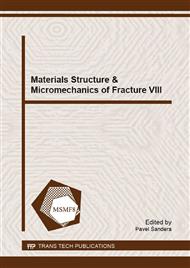p.460
p.465
p.469
p.473
p.477
p.481
p.485
p.489
p.495
Study of Initial Stages of Fatigue Process in Selective Laser Melting Material Using Acoustic Emission Method
Abstract:
This paper deals with the evaluation of the fatigue tests and subsequent analyses of damage processes in selective laser melting (SLM) materials under bending loading. Compared to conventional production technologies (casting, forming and machining), SLM offers a wide range of benefits, e.g. production with no need for expensive molds, very low material waste and the possibility to create complex geometric shapes. The acoustic emission method was used to fully understand the processes which appear in the stages preceding the crack initiation. The fatigue tests at room temperature were conducted on standard wrought 2618A aluminium alloy as a representative testing material and the same material created by SLM. The main aim of the study was to compare the acoustic emission signal during fatigue loading at different manufacturing parameters of SLM material and to analyze in detail the signal changes in initial stages of fatigue process. The results show the high sensitivity of the acoustic emission technique to the fracture behaviour of SLM material and transition from the stage of surface relief evolution to the stage of crack nucleation and propagation. After completion of dynamic mechanical tests, a detailed fractographic analysis was conducted to assess material response to mechanical loading. Attention was focused on determining the predominant failure mechanisms and the influence of defects or inhomogeneities such as pores, cavities, etc. resulting from the production of materials using SLM method.
Info:
Periodical:
Pages:
477-480
Citation:
Online since:
December 2016
Price:
Сopyright:
© 2017 Trans Tech Publications Ltd. All Rights Reserved
Share:
Citation:


